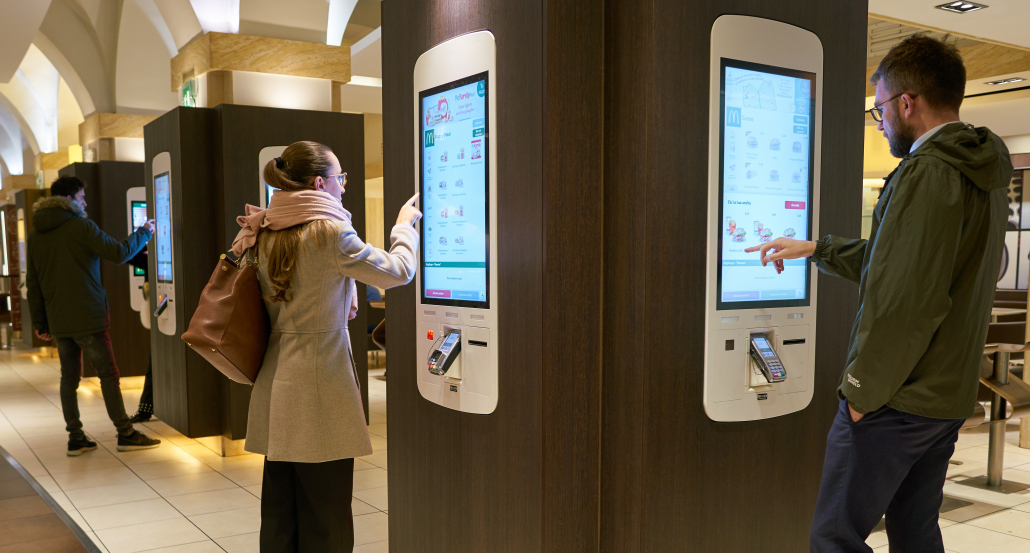Machines in the middle: infection transmission via touchscreens
In the last few months, what we touch – and who else has touched it – has suddenly become a critical thought process that very few people thought of previously. Touch screens, devices, kiosks, fuel pumps – people are a lot more conscious of what they have to touch, and the implications of hygiene on every day life.
By 2024, the hand sanitiser market is set to grow to $5.5 billion, evidence of a world that is increasingly aware of – and more at risk from – infectious germs. But while the onus to keep our hands clean usually comes from settings such as bathrooms and door handles, there’s another, less obvious culprit: touchscreens. Smartphones, fitness trackers, tablets, ATMs, check in screens, self-service kiosks and more. We take them all for granted, but the thousands of fingers swiping, touching and scrolling are inevitably transferring germs to and from their surfaces. And some of these germs have the potential to cause real harm.
Speaking to the New York Times, Dr Dubert Guerrero, an infectious disease specialist and co-author of a study about the persistence of bacteria on iPads, stresses they absolutely can be a source of disease transmission and, like your toothbrush, “your mobile device is something you want to clean regularly.”
Yet even though it’s a simple task, we do so infrequently or ineffectively. After all, touchscreens are such an ingrained part of life these days that we barely consider how often we use them. There is also a common misconception that, as a non-porous surface, they are less likely to harbour germs. The result is that touchscreens are shown to carry more bacteria than most toilet seats and this makes it all the more startling when you discover that many people admit to never cleaning their smartphones.
Given that Norovirus (sometimes called the ‘winter vomiting bug’) is shown to survive for weeks on a hard surface, this is a fallacy that needs urgently addressing, particularly in the light of ‘superbugs’ – antibiotic resistant bacteria that cause tens of thousands of deaths each year. It’s an issue that the World Health Organisation describes as “a major concern because a resistant infection may kill, can spread to others, and imposes huge costs to individuals and society.” The heat emitted by touchscreens also provides a near perfect environment for these bacteria to reproduce and germs to thrive.
Preventative measures
While cleaning is important, in a setting such as a stadium or 24-hour ATMs, it’s often impractical, but there are many effective adjustments that can be made to suit the application. Single, seamless screens, without gaps or bevels are perhaps the most obvious measure to take when designing for challenging settings, removing the difficult-to-clean crevices in which dirt and bacteria settle.
Building antimicrobial protection into the screens themselves is also a highly effective and viable option. Kastus, for example, manufacture a range of surface coatings for screens which permanently block up to 99.99% of resistant bacteria, such as MRSA, E. coli and C. diff. It’s added to the glass of the device during manufacturing and subsequently protects the surface for its lifetime without any noticeable difference to functionality.
However, in a clinical and sterile setting, such as operating rooms or intensive care, it’s critical to apply even stronger steps. In this scenario, both the measures above would be used in tandem with HMI technology sealed in specially designed sterile ‘shield bags’, which can be used with many types of digital device. In the case of large monitoring touchscreens, these are designed to meet the robustness required in a surgical environment and can easily withstand deep cleaning to a sterile standard before each surgery.
Assess and address
Overall, it’s important to look at the individual environment, and assess the ways and places screens are required, used and maintained before investigating an appropriate solution. Temperatures, moisture levels, contaminants and usage levels all determine the technology that should be used when designing HMIs. In a normal working environment you are looking to reduce the opportunity for infection transmission and maintain the wellbeing of employees and visitors. So, it might simply be that ensuring a hygiene policy is in place and enforcing regular, thorough cleaning of devices is enough. An airport, at the other extreme, will need to address the risks of many thousands of travellers using the same screens and the potential for pathogens to migrate well beyond the building walls.
It’s not a challenge that any business needs to address alone. Our experts are on hand to work with you in designing an effective solution that’s bespoke to the needs of your environment.
Contact the Avnet Embedded team to learn more about how we can assist you.




